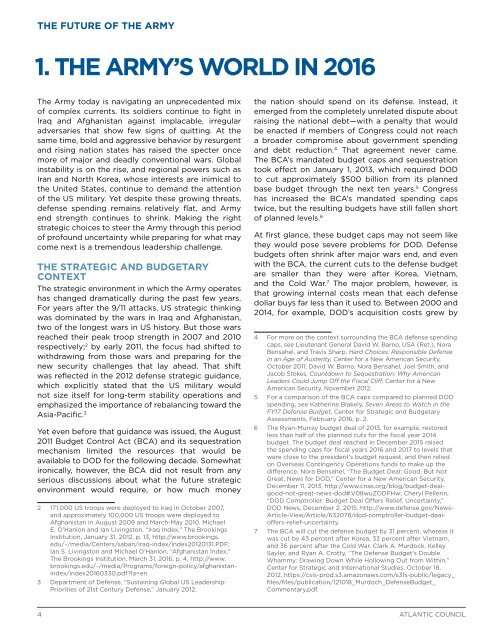FUTURE ARMY
Future_of_the_Army_web_0921
Future_of_the_Army_web_0921
Create successful ePaper yourself
Turn your PDF publications into a flip-book with our unique Google optimized e-Paper software.
THE <strong>FUTURE</strong> OF THE <strong>ARMY</strong><br />
1. THE <strong>ARMY</strong>’S WORLD IN 2016<br />
The Army today is navigating an unprecedented mix<br />
of complex currents. Its soldiers continue to fight in<br />
Iraq and Afghanistan against implacable, irregular<br />
adversaries that show few signs of quitting. At the<br />
same time, bold and aggressive behavior by resurgent<br />
and rising nation states has raised the specter once<br />
more of major and deadly conventional wars. Global<br />
instability is on the rise, and regional powers such as<br />
Iran and North Korea, whose interests are inimical to<br />
the United States, continue to demand the attention<br />
of the US military. Yet despite these growing threats,<br />
defense spending remains relatively flat, and Army<br />
end strength continues to shrink. Making the right<br />
strategic choices to steer the Army through this period<br />
of profound uncertainty while preparing for what may<br />
come next is a tremendous leadership challenge.<br />
THE STRATEGIC AND BUDGETARY<br />
CONTEXT<br />
The strategic environment in which the Army operates<br />
has changed dramatically during the past few years.<br />
For years after the 9/11 attacks, US strategic thinking<br />
was dominated by the wars in Iraq and Afghanistan,<br />
two of the longest wars in US history. But those wars<br />
reached their peak troop strength in 2007 and 2010<br />
respectively; 2 by early 2011, the focus had shifted to<br />
withdrawing from those wars and preparing for the<br />
new security challenges that lay ahead. That shift<br />
was reflected in the 2012 defense strategic guidance,<br />
which explicitly stated that the US military would<br />
not size itself for long-term stability operations and<br />
emphasized the importance of rebalancing toward the<br />
Asia-Pacific. 3<br />
Yet even before that guidance was issued, the August<br />
2011 Budget Control Act (BCA) and its sequestration<br />
mechanism limited the resources that would be<br />
available to DOD for the following decade. Somewhat<br />
ironically, however, the BCA did not result from any<br />
serious discussions about what the future strategic<br />
environment would require, or how much money<br />
2 171,000 US troops were deployed to Iraq in October 2007,<br />
and approximately 100,000 US troops were deployed to<br />
Afghanistan in August 2009 and March-May 2010. Michael<br />
E. O’Hanlon and Ian Livingston, “Iraq Index,” The Brookings<br />
Institution, January 31, 2012, p. 13, http://www.brookings.<br />
edu/~/media/Centers/saban/iraq-index/index20120131.PDF;<br />
Ian S. Livingston and Michael O’Hanlon, “Afghanistan Index,”<br />
The Brookings Institution, March 31, 2016, p. 4, http://www.<br />
brookings.edu/~/media/Programs/foreign-policy/afghanistanindex/index20160330.pdf?la=en.<br />
3 Department of Defense, “Sustaining Global US Leadership:<br />
Priorities of 21st Century Defense,” January 2012.<br />
the nation should spend on its defense. Instead, it<br />
emerged from the completely unrelated dispute about<br />
raising the national debt—with a penalty that would<br />
be enacted if members of Congress could not reach<br />
a broader compromise about government spending<br />
and debt reduction. 4 That agreement never came.<br />
The BCA’s mandated budget caps and sequestration<br />
took effect on January 1, 2013, which required DOD<br />
to cut approximately $500 billion from its planned<br />
base budget through the next ten years. 5 Congress<br />
has increased the BCA’s mandated spending caps<br />
twice, but the resulting budgets have still fallen short<br />
of planned levels. 6<br />
At first glance, these budget caps may not seem like<br />
they would pose severe problems for DOD. Defense<br />
budgets often shrink after major wars end, and even<br />
with the BCA, the current cuts to the defense budget<br />
are smaller than they were after Korea, Vietnam,<br />
and the Cold War. 7 The major problem, however, is<br />
that growing internal costs mean that each defense<br />
dollar buys far less than it used to. Between 2000 and<br />
2014, for example, DOD’s acquisition costs grew by<br />
4 For more on the context surrounding the BCA defense spending<br />
caps, see Lieutenant General David W. Barno, USA (Ret.), Nora<br />
Bensahel, and Travis Sharp, Hard Choices: Responsible Defense<br />
in an Age of Austerity, Center for a New American Security,<br />
October 2011; David W. Barno, Nora Bensahel, Joel Smith, and<br />
Jacob Stokes, Countdown to Sequestration: Why American<br />
Leaders Could Jump Off the Fiscal Cliff, Center for a New<br />
American Security, November 2012.<br />
5 For a comparison of the BCA caps compared to planned DOD<br />
spending, see Katherine Blakely, Seven Areas to Watch in the<br />
FY17 Defense Budget, Center for Strategic and Budgetary<br />
Assessments, February 2016, p. 2.<br />
6 The Ryan-Murray budget deal of 2013, for example, restored<br />
less than half of the planned cuts for the fiscal year 2014<br />
budget. The budget deal reached in December 2015 raised<br />
the spending caps for fiscal years 2016 and 2017 to levels that<br />
were close to the president’s budget request, and then relied<br />
on Overseas Contingency Operations funds to make up the<br />
difference. Nora Bensahel, “The Budget Deal: Good, But Not<br />
Great, News for DOD,” Center for a New American Security,<br />
December 11, 2013, http://www.cnas.org/blog/budget-dealgood-not-great-news-dod#.V08wuZODFHw;<br />
Cheryl Pellerin,<br />
“DOD Comptroller: Budget Deal Offers Relief, Uncertainty,”<br />
DOD News, December 2, 2015, http://www.defense.gov/News-<br />
Article-View/Article/632078/dod-comptroller-budget-dealoffers-relief-uncertainty.<br />
7 The BCA will cut the defense budget by 31 percent, whereas it<br />
was cut by 43 percent after Korea, 33 percent after Vietnam,<br />
and 36 percent after the Cold War. Clark A. Murdock, Kelley<br />
Sayler, and Ryan A. Crotty, “The Defense Budget’s Double<br />
Whammy: Drawing Down While Hollowing Out from Within,”<br />
Center for Strategic and International Studies, October 18,<br />
2012, https://csis-prod.s3.amazonaws.com/s3fs-public/legacy_<br />
files/files/publication/121018_Murdoch_DefenseBudget_<br />
Commentary.pdf.<br />
4 ATLANTIC COUNCIL


